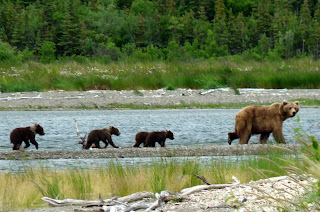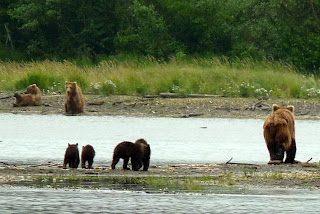Katmai National Park extends for 340 miles along the Alaskan Peninsula, 4.7 million acres just west of Kodiak Island. Volcanoes, bears and salmon are the main attractions, but the park is not particularly accessible. There are no roads - just enormous lakes and bays studded with islands, rushing rivers and streams, huge mountains with wind-whipped passes, and lots of challenging coastline. We sampled just a tiny piece of this amazing place - we did indeed see bears and salmon, but also magpies, moose, ducks, sea gulls.
The park was established to protect an outstanding example of volcanism. It is located along the crest of the Pacific Rim of Fire; in 1912, one of the greatest volcanic explosions in recorded history turned a nameless green field into what is now known as the Valley of Ten Thousand Smokes. When it blew, it released 10 times more energy than Mount St. Helens' eruption in 1980; all life within a 40-mile radius was wiped out and buried under ash to depths of 700 feet.
Katmai is better known today as the spawning grounds for millions of sockeye salmon, which attract the largest Brown bear population in the world. There are over 2,000 brown bears at Katmai and about fifty of them live along the mile and a half Brooks River during the salmon season. During the peak of the salmon run, the bears congregate at Brooks Falls for easy fishing as the red salmon try to pass up the falls.
Brown bears are genetically identical to grizzly bears, but the grizzlies live 100 miles or more inland and the browns are generally much larger due to their coastal diet of salmon. These Alaskan brown bears average a thousand pounds in weight and measure up to 10 feet in height - they are easily the largest carnivores on the North American continent.
Our trip to Katmai began in a propjet aircraft, about 1.5 hours flight from Anchorage to King Salmon, Alaska. King Salmon appears to consist of an airstrip and a fish cannery; would not want to be stranded there. We transferred by bus to the river to board the floatplane that delivered us to Brooks Lodge. This was a short 25-minute flight over mostly muskeg - a few trees, lots of lakes and streams, and miles of thick, green, green moss.
Our plane landed on Naknek Lake, and as our plane taxied to the beach, we saw a female bear with two cubs. They seem unconcerned by our arrival - it was just a nice day for a stroll along the shore.
The first order of business was bear orientation by a park ranger - the School of Bear Etiquette - how to behave while exploring in bear country. First they scare the daylights out of you and then they try to convince you that you'll be just fine if you don't freak out when you encounter a bear. In short, the rules are: (1) Avoid disturbing the bears at all - if they don't see you, change your course and move out of the area slowly. (2) If you do unexpectedly encounter a bear, do be sure he is aware of your presence - talk calmly to the bear and stand your ground - he'll probably go away. (3) If a bear approaches you, be assertive - stand tall, look big and make a lot of noise - do not retreat even if he charges. (4) If the bear makes contact, it's time for your bear pepper spray; if it's a brown bear, play dead; if it's a black bear, fight back. (5) If you find yourself in a defensive bear encounter - bear defending food or female defending cubs - add prayer to the list above.
We're staying at Brooks Lodge, which overlooks the Naknek Lake in the heart of Katmai National Park. The lodge has 16 rooms - it was originally a fishing camp, but today it's full of folks eager to see bears. After we checked in, we had a personal escort to our room - he helped with our luggage, but mostly it was another opportunity to be sure we're ready for bears.
And we were grateful for the opportunity to get into our luggage - we pulled out most of our clothes and put them on! With a little misty rain, temperatures in the fifties and a stiff breeze, it was right chilly for wandering around outside. We soon learned that we should be happy that it was cold - on warm days, the famous Alaskan black flies are unbearable - we heard all sorts of tales of the misery wrought by these little monsters.
This area has the largest population of protected brown bears in the world, and during the summer sockeye salmon runs, the Brooks River is the focus of bears feeding in the park. The river is a half-mile from the lodge and bears can be seen all along the trail. The rangers are in constant motion and on full alert, watching for bears and helping idiot human visitors avoid surprise meetings with bears.
At the river, there is a floating bridge, with gates at both ends to discourage the bears from crossing on the bridge itself. On the far side of the river is a viewing platform, from which we could see up and down the river, as well as along part of the shore of Naknek Lake. On our first trip across the river, we learned the bridge is often closed because of bears too close to one end or the other.
Just as we crossed, along came the female bear with two cubs - just out for a walk. They didn't seem particularly interested in the bridge and viewing platform, they're just looking for fish or a quiet spot to take a nap. We learned that females frequent this area because it's a safe distance from the ornery males, who sometimes attack and eat cubs.
From the bridge at the river, it's another mile to an elevated viewing platform near the Brooks River falls. This trail goes through some dense forest and bear trails criss-cross the human trail. Expecting a bear around every turn, we tried to make this trek with others walking in the same direction!
Out at the falls, it's another world -- bears were everywhere. We saw as many as twelve at one time fishing in and around the falls.



When we headed back to the lodge, the bridge was closed again. This time it was a single bear - named Holly - who decided to check the whole neighborhood for a good fishing spot. Again, she didn't seem worried about us or the bridge - except that it might provide a better vantage point for seeing the fish.
We were stranded there for about 45 minutes while this bear, later joined by a mother with cubs, wandered up, down and around. We heard that some folks were stuck here the previous night for nearly 3 hours, so we got off easy. And the rangers radioed back and forth to have the departing float plane wait for a couple of passengers who were stranded with us.
We made it back to the lodge and got some hot drinks and a spot near the fireplace. As soon as we got warmed up, we went back to the falls - more bears.


Suppertime (for humans) approached, so we headed back to the lodge - only to get trapped on the bridge again. This could have been a serious problem if these guys had made us miss a meal, but it was good - plenty of entertainment from the bears and great stories from the rangers.
Dinner at the lodge was nothing exciting, but we sat with a couple of folks visiting from Australia and we thoroughly enjoyed talking with them. They are on a three-month visit to the U.S.; this is not their first trip - they know more about this country than we do! We shared travel stories, plans and wishes until time for the evening ranger program, which was a slide show and talk on the park and its wildlife.














No comments:
Post a Comment